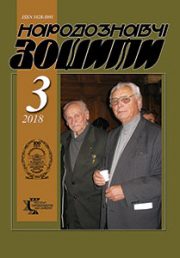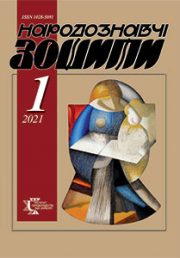The Ethnology Notebooks, 2018, № 5 (143), 1290—1297
UDK 741.071.1(477)”18″ Шевченко
DOI https://doi.org/10.15407/nz2018.05.1290
Received 13.08.2018
ARTISTIC FEATURES OF TARAS SHEVCHENKO’S SEPIAS OF 1856
ORCID ID: https://orcid.org/0000-0002-9808-7997
Gomyreva Olena Ivanivna, lecturer at the Department of Art Theory and History
of National Academy of Fine Arts and Architecture
Voznesenskui lowering, 20, Kyiv, 02000, Ukraine
Contacts: tel. +38 099 649 48 12. E-mail: lenagom.g1@gmail.com.
Abstrakt. The presented research is devoted to the stylistic features of Taras Shevchenko’s sepia series named «TelemachDiogenes» or «Suite of Solitude» and created in 1856. The article considers the features of subject solutions, composite and chiaroscuro arrangement of images, the author’s application of sepia technique. The methodology of the article is based on the methods of formal, comparative and iconographic analysis, which give an opportunity to explore the means of expressiveness and the principles of composition of works in this series. The scientific novelty of the research is to determine the characteristic features of artist’s work in 1856 and to explore new changes in his artistic manner in last years of exile. The tendencies of academism, romanticism, realism and folk art in the specifics of these works are revealed. The analysis showed the peculiarity of the artist’s interpretation of light, his use of contrasts, his methods of creating spatial effects, of balancing and unifying the composition.
Keywords: Taras Shevchenko, sepia, «Suite of Solitude», analysis, chiaroscuro, contrast, composition.
REFERENCES
Halajchuk, Y. (1961). Suite of Solitude (To the issue of the series of drawings “Telemak-Diogenes” by T. Shevchenko). Pytannia shevchenkoznavstva, 2, 68–93 [in Ukrainian].
Hal’chuk, O. (2014). Diogenes and Robinson Crusoe in Shevchenko’s paradigm of perfect heroes. Shevchenko Studies, 18, 250–257 [in Ukrainian].
Heneraliuk, L. (2008). Shevchenko’s universalism: Interaction of literature and art. Kyiv: Naukova dumka [in Ukrainian].
Hordijchenko, V. (2012). Christian symbolics in T. Shevchenko’s art. Symbols and allegory of images. Humanities Bulletin of Zaporizhzhe State Engineering Academy, 51, 74–86 [in Ukrainian].
Kasijan, V. (1939). On the dating of some sepia works T. Shevchenko. Iskusstvo, 2, 53–58 [in Russian].
Majstrenko, M. (1999). Ancient themes in Shevchenko’s art works of the time of exile. The Problems of Contemporary Literary Studies, 3, 94–98 [in Ukrainian].
Ovsijchuk, V. (2008). Taras Shevchenko’s artistic heritage in the context of European artistic culture. L’viv: The Ethnology Institute of National Academy of Sciences of Ukraine [in Ukrainian].
Palamarchuk, H. (1968). Unbowed Prometheus: Creativity of Shevchenko-artist from 1850 to 1857. Kyiv: Mystetstvo [in Ukrainian].
Stepovyk, D. (2014). Sacred subjects in Taras Shevchenko’s art. Fine art, 1, 14–18 [in Ukrainian].
Tarakhan-Bereza, Z. (1982). Shevchenko’s drawings of years of exile on historical and mythological themes. Digest of articles of the twenty-fourth Scientific Shevchenko Conference, 198–209 [in Ukrainian].
Shyrots’kyj, K. (1911). Religious motifs in Shevchenko’s paintings. Nyva, 5, 129–137 [in Ukrainian].






